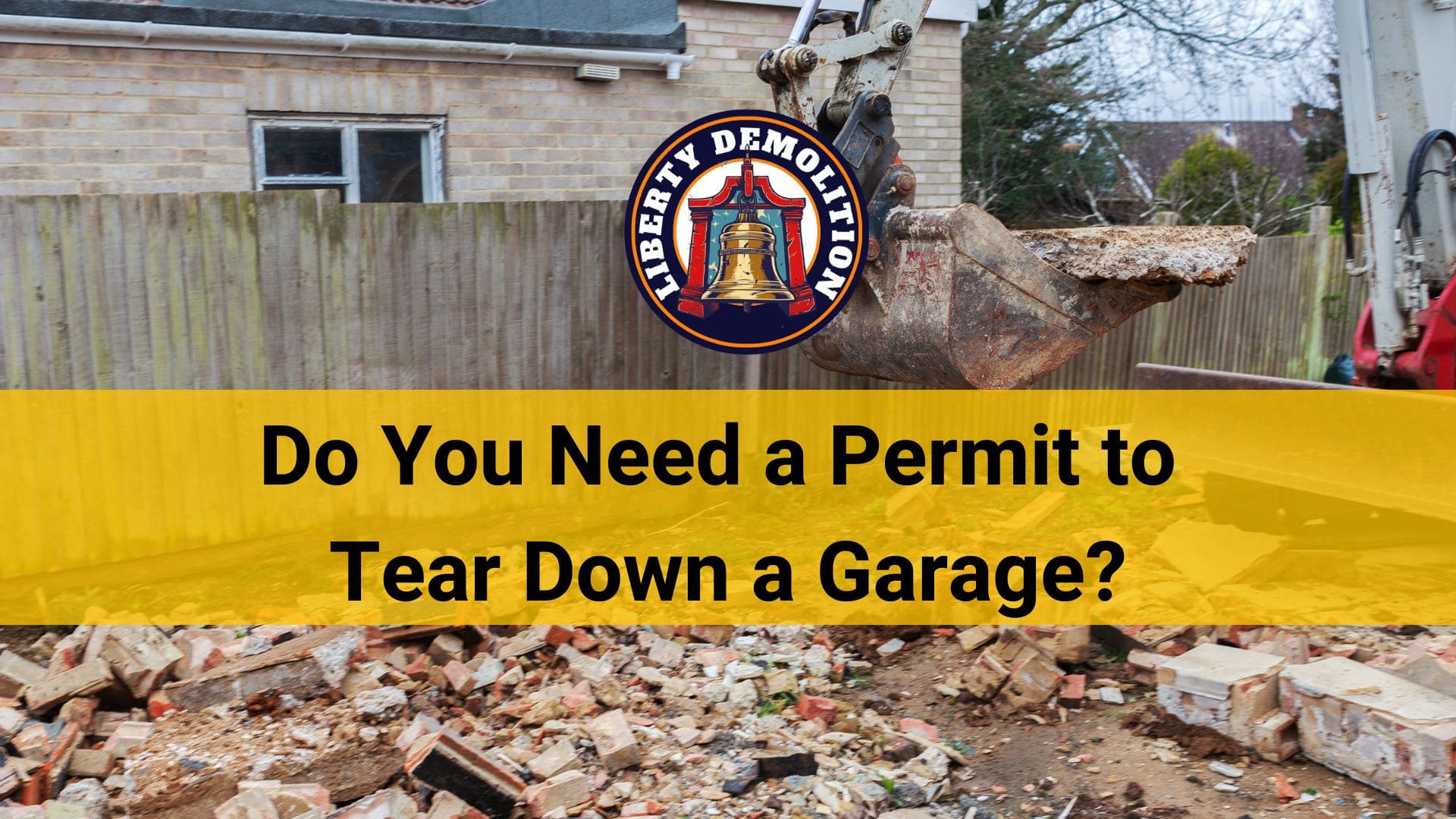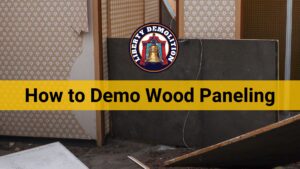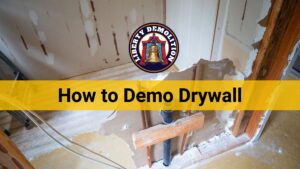Yes, you typically need a permit to tear down a garage. It ensures adherence to local regulations, maintains safety, and preserves historical or environmentally sensitive sites. The specifics may vary by locality, but it’s essential to consult with local building departments before proceeding.
Discover more about why do you need a permit to tear down a garage and the processes involved in the guide below.
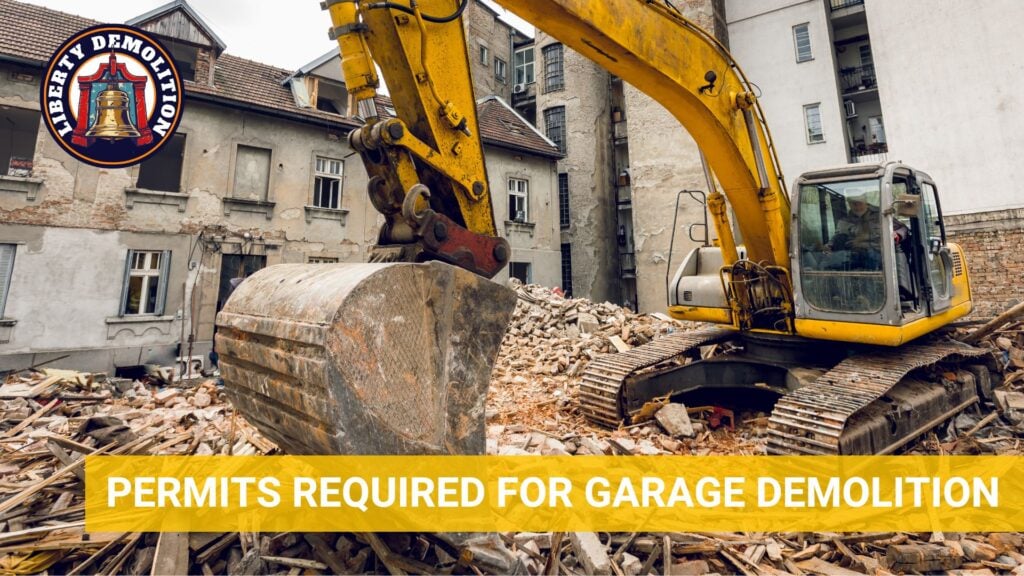
Permits Required for Garage Demolition
Garage demolitions, like other types of demolition activities, are subject to various local and state regulations. Given the nature of garages, which often house vehicles, chemicals, or tools, the correct demolition process is vital for safety and environmental reasons.
Necessity for a Permit
A demolition permit for a garage, much like for other structures, is a document issued by a local governing authority. It grants permission to safely and legally demolish a garage.
Reasons:
- Safety. Garages can contain hazardous materials (e.g., paint, pesticides, fuels) that need special handling. The demolition might also affect utilities, requiring coordination.
- Environmental Concerns. Inappropriate disposal of materials could harm the environment.
- Structural Integrity. The demolition could impact nearby structures or underground utilities.
- Historical Considerations. Some garages, especially in older neighborhoods, might have historical significance.
- Land Use & Zoning Laws. The future use of the land post-demolition might be subject to regulations.
Requirements in Getting a Demolition Permit
To secure a demolition permit, the following steps are typically required:
- Submission of a filled-out permit application.
- Provision of an approved grading plan for specific demolition tasks.
- Fulfillment and inspection of the necessary plumbing permit.
- In certain localities, a refundable cash demolition escrow bond is mandated to guarantee the demolition is executed safely, cleanly, and securely.
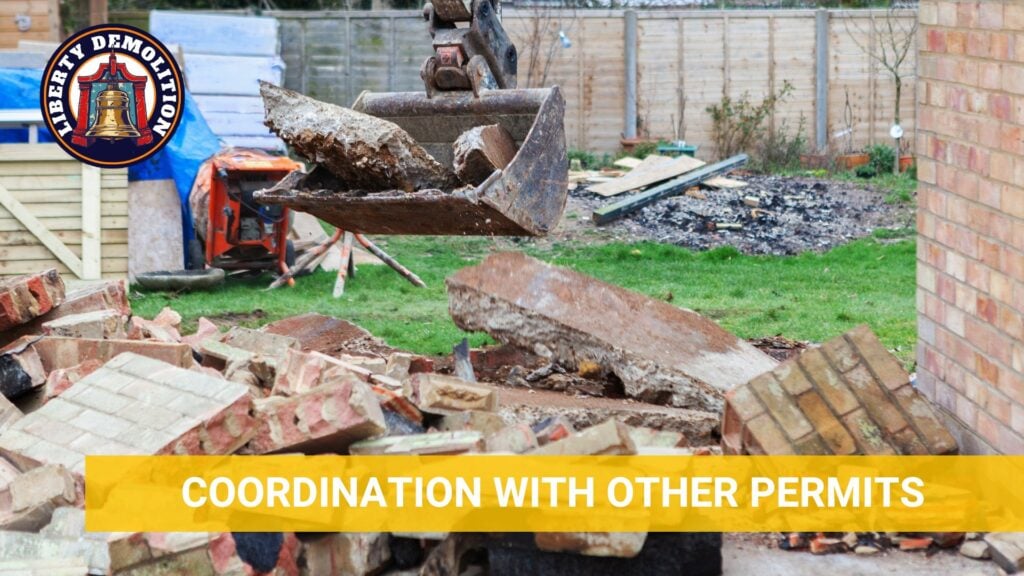
Do You Need a Permit to Tear Down a Garage: Coordination with Other Permits
Often, a demolition permit is one of several permits needed. Others could include environmental permits, especially if there’s asbestos removal, or grading permits if there’s substantial land alteration.
Exceptions to Permit Requirements
Lands or structures owned by governmental bodies, be it federal, state, or local, might have different protocols when it comes to demolition.
Implications:
- Sovereign Immunity. In some jurisdictions, governmental bodies might have sovereign immunity, meaning they aren’t subject to certain local regulations. Thus, they might bypass standard permit procedures.
- Internal Protocols. Even if exempted from local regulations, governmental bodies often have their own rigorous internal standards and protocols for demolitions. This is to ensure safety and environmental protection.
- Interagency Coordination. For projects on government-owned land, multiple agencies might be involved, which requires coordination and approvals from each.
Minor Structural Changes
In some cases, if the garage demolition is minor or is more of a renovation than a complete teardown, local authorities might not require a full demolition permit. However, other permits, like building or renovation permits, might still be needed.
Emergency Situations
In cases of natural disasters, fires, or other emergencies where a structure becomes an immediate threat, there might be expedited or waived permit processes to allow for quick demolition.
Rural or Unincorporated Areas
Some rural or unincorporated regions might have laxer regulations when it comes to demolishing smaller structures like garages. It’s essential, however, to verify with the nearest governing body.
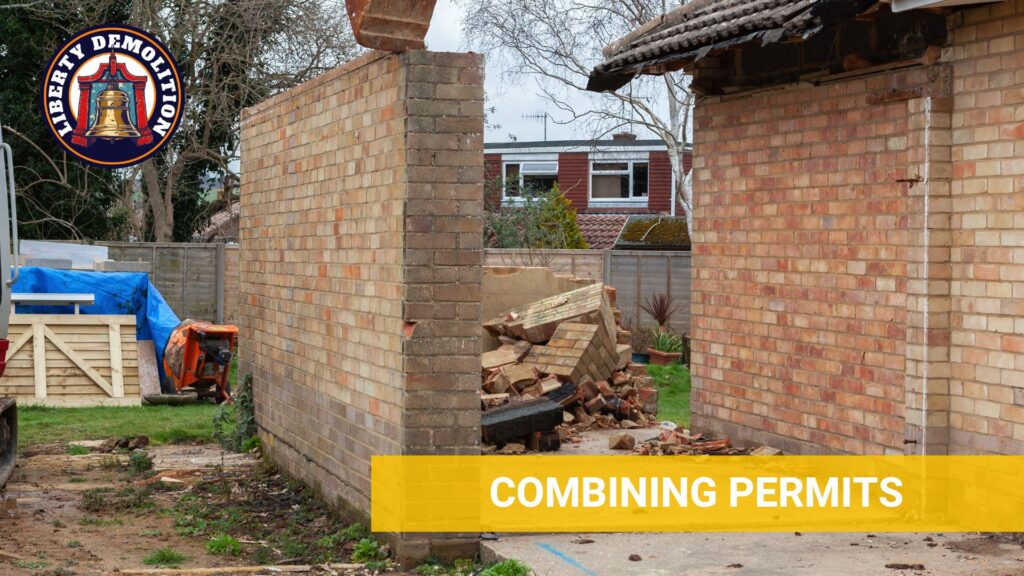
Combining Permits for Single-Family Dwellings and Accessory Buildings
Combined permits are streamlined permits that cover both a main structure (like a single-family dwelling) and its accessory buildings (like garages, sheds, etc.) within a single document. This approach is designed to reduce paperwork, expedite the approval process, and offer convenience to the property owner.
Advantages:
- Simplicity. One of the primary benefits of combined permits is the reduction in administrative work. Property owners only need to submit one application, pay one fee, and track one permit.
- Cost Savings. While not universal, some municipalities may offer a reduced fee for combined permits, as the administrative overhead is decreased.
- Consistent Oversight. By combining permits, the local authority can maintain a more cohesive overview of all the demolition activities on a particular property, ensuring that all activities align with zoning and environmental regulations.
Limitations:
- Scope. The scope of the demolition work for both the main structure and accessory buildings must be well-defined. Expanding the scope may require adjustments or amendments to the permit.
- Dependencies. If the demolition of the main dwelling depends on the prior demolition of the accessory structure or vice versa, the timelines and sequence of events must be explicitly stated in the permit.
Application Process:
Typically, the property owner or contractor will specify their intention to demolish both the primary dwelling and any accessory structures in their initial application. The combined permit will then detail the requirements for each structure. This is to ensure all are met before the demolition begins.

Clearances Required for Garage Demolition
The demolition of structures, especially garages that may be older or in significant areas, may require various clearances. These clearances serve to ensure that demolitions are compliant with city planning, environmental, historical, and safety guidelines.
Before issuing a demolition permit, several clearances might be required, such as:
- Zoning compliance checks
- Areas designated for historical preservation
- Historical monument zones
- Protections under the Coastal Zone Conservation Act
- Validation of redevelopment project territories
- Regulations relating to rent stabilization
- Safety clearances from OSHA for edifices three stories or taller
- Approval from the Department of Public Works Urban Forestry Division for potential interference or removal of safeguarded trees
Here’s a detailed look into the important clearances you need to accomplish before beginning the demolition of your garage:
Redevelopment Clearances
Their purpose is to ensure that the planned demolition aligns with city or local development plans and zoning requirements. The local city or town planning department reviews the demolition request in the context of broader redevelopment plans. They see to it that the demolition doesn’t adversely affect future development or violate zoning ordinances.
This clearance is crucial if the demolition is part of a larger redevelopment project. This way, you can assure that the demolition and any subsequent constructions align with local plans.
Benefits:
- Ensures sustainable urban development.
- Avoids potential land use conflicts in the future.
Historical Preservation Clearances
These aim to protect structures with significant historical, cultural, or architectural value. If a garage or accompanying structure is believed to be of historical significance, the local historical or heritage preservation commission must evaluate it.
This body will determine whether the structure should be preserved, refurbished, or can be demolished. If preservation is mandated, demolition may be restricted or prohibited.
Benefits:
- Preserves the cultural and historical heritage of a community.
- Ensures that valuable architectural designs and styles aren’t lost.
Environmental Clearances
The purpose of these clearances is to ensure that the demolition doesn’t negatively impact the environment, especially concerning soil, water, air quality, and ecosystems. Environmental assessments might be required to determine if the demolition will release hazardous materials or disturb local ecosystems.
If potential hazards like asbestos, lead, or chemicals are detected, additional precautions, abatement, or remediation might be required before demolition.
Benefits:
- Safeguards community health by preventing the release of hazardous materials.
- Protects local ecosystems from disturbances.
Safety and Structural Clearances
They ensure that the demolition is safe and won’t jeopardize adjacent structures or public spaces. Before the demolition, a structural assessment is conducted to understand the building’s integrity and how it can be safely demolished.
This clearance might dictate specific demolition techniques, especially if the structure is adjacent to other buildings or public areas.
Benefits:
- Ensures public safety during the demolition process.
- Minimizes risks of unintended damages to nearby structures.
Public Input and Neighborhood Clearances
These clearances allow community members to voice any concerns or inputs about the planned demolition. Depending on local regulations, public hearings or community meetings might be required before granting a demolition permit. Residents and businesses in the vicinity can provide feedback, concerns, or support for the demolition.
Benefits:
- Enhances transparency and community involvement in developmental decisions.
- Helps address potential issues or disputes ahead of time.
Do You Need a Permit to Tear Down a Garage: Understanding Local Regulations
Local authorities play an important role in overseeing and regulating garage demolitions within their jurisdiction.
The Roles of Local Authorities in Regulating Demolitions
Setting Standards and Guidelines
Every local authority establishes specific codes, standards, and regulations for demolition. This is to ensure that any teardowns are carried out safely, efficiently, and with minimal environmental impact. These standards might cover everything from how debris should be disposed of to what safety measures must be in place during the demolition.
Protection of Public Interest
One primary concern of local authorities is the well-being of the community. By regulating garage demolitions, they ensure that no activities endanger residents, nearby properties, or public utilities.
Historical and Environmental Conservation
In many locales, there might be regulations in place to protect historically significant structures or those located in environmentally sensitive areas. Local authorities help identify whether a garage or any structure can be torn down without violating these conservation principles.

The Importance of Checking with Local Building Departments
Before doing any demolition project, including that of a garage, it’s important to consult with the local building department for several reasons:
Acquisition of Necessary Permits
Demolishing any structure usually requires a permit. The local building department will provide guidelines on how to secure this permit, what documentation is needed, and any associated fees.
Awareness of Local Codes
Every region has specific codes and regulations related to demolitions. These might include stipulations about noise levels, times during which demolition can occur, or disposal methods for debris. Checking in advance can save time, money, and potential legal headaches.
Safety Protocols
Local building departments will outline mandatory safety protocols that need to be followed. This might include things like ensuring utility lines are shut off or that protective barriers are erected around the demolition site.
Variations in Regulations Depending on the Location
Regulations related to garage demolitions can vary widely depending on where one is located:
Urban vs. Rural Settings
Urban areas, with their higher density, might have stricter regulations about noise, dust control, and hours of operation than more rural settings.
Historical Districts
In areas designated as historical districts, there might be stringent rules or even prohibitions against demolishing structures, even if they’re just garages.
Environmentally Sensitive Zones
For garages located near wetlands, coastal areas, or other environmentally protected zones, there might be additional checks, balances, and procedures in place to ensure minimal ecological disruption.
State and Country Variances
Beyond local municipalities, state or even country-level regulations might apply. Some regions have more policies that override or add to local codes.
Ensure There Are No Loopholes in Tearing Down Your Garage
Considering tearing down structures like garages, requires more than just a basic understanding about the legalities. The necessity of permits and the stringent safety protocols all underscore the importance of thorough preparation and adherence to local regulations.
While it might seem difficult at first, remember: you don’t have to do it alone. We at Liberty Demolition are well-versed in every aspect of the demolition process. With our commitment to safety, environmental responsibility, and unparalleled customer satisfaction, we bring not just expertise but a pledge of excellence to the table. Whether it’s residential, commercial, industrial, or selective demolition, we ensure the process is executed seamlessly, and with the added assurance of eco-friendly waste management and recycling practices.
Plus, we will help you with all the necessary permits involved, depending on the details of your project. So, what are you waiting for? Call us today and let our professional demolition contractors handle all the work (including the paperwork). Because with Liberty, we’re not just tearing down structures; we’re building a foundation for a safer, greener tomorrow.

